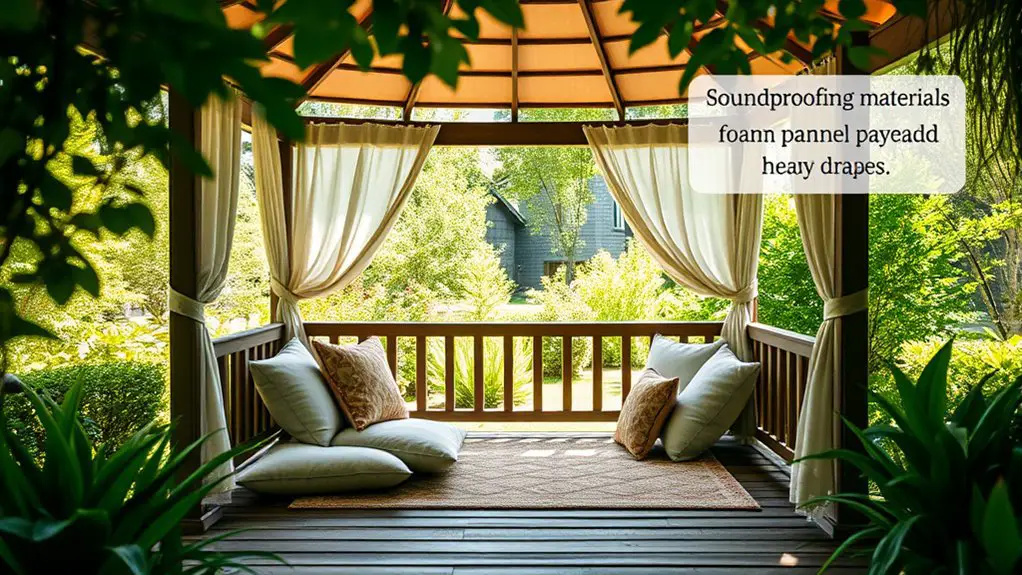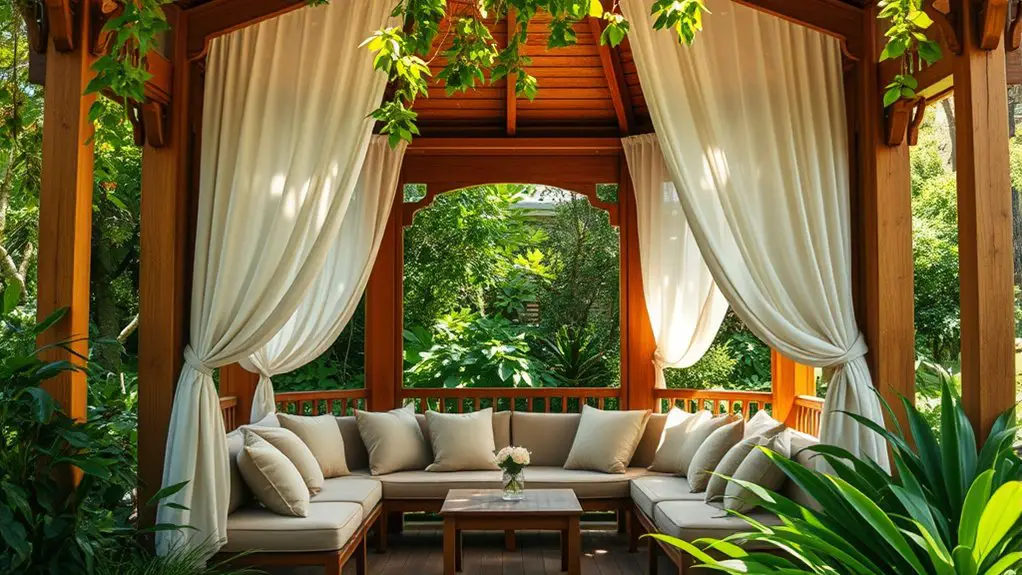To create a relaxing soundproof gazebo retreat, start by evaluating noise levels from nearby roads or neighbors. Use acoustic foam and soundproof insulation to absorb sound, placing panels at first reflection points for best effect. Incorporate natural barriers like dense shrubs and evergreens, and add heavy curtains for additional noise reduction. Combining these elements transforms your gazebo into a tranquil escape. There’s more to know about enhancing your space effectively and stylishly.
Assessing Your Gazebo’s Noise Levels

Have you ever wondered how much noise your gazebo actually attracts? Understanding the noise sources around your outdoor retreat is essential for creating a peaceful environment. Start by identifying common culprits like nearby roads, bustling neighbors, or even wind rustling through trees. Use a sound level meter app on your smartphone to measure decibel levels during different times of the day. This’ll help you pinpoint peak noise times and determine how disruptive those sound levels are to your relaxation.
Once you’ve assessed the noise landscape, consider how it affects your enjoyment. If you find certain sounds are particularly bothersome, you can strategize effective solutions for soundproofing later. Remember, knowledge is power; the more you know about the noise surrounding your gazebo, the better equipped you’ll be to create that serene escape you crave. Your peaceful retreat is just a few assessments away!
Choosing the Right Soundproofing Materials
After pinpointing the noise sources affecting your gazebo, the next step is selecting the right soundproofing materials to create that tranquil atmosphere you desire. Start with acoustic foam, which can easily absorb sound waves and reduce echoes. It’s lightweight and available in various shapes and sizes, making it a versatile option for your space.
Next, consider soundproof insulation. This material can be added to walls or ceilings to minimize outside noise intrusion. Look for options specifically designed for soundproofing, as they’ll provide the best results.
Combining these two materials can considerably enhance your gazebo’s serenity. You can use acoustic foam panels on walls or ceilings while layering soundproof insulation behind them. This dual approach not only dampens sound but also creates a cozy, inviting retreat. With the right materials, you’ll be well on your way to enjoying peaceful moments in your gazebo.
Installing Acoustic Panels for Enhanced Sound Absorption

While you may be enthusiastic to enjoy your newly soundproofed gazebo, the installation of acoustic panels is essential for enhancing sound absorption. Start by selecting the right acoustic panel types for your space—foam panels, fabric-wrapped panels, or wooden slat panels can all work wonders. Each type has its own unique aesthetic and sound-dampening qualities.
Before you begin, gather your tools: a measuring tape, adhesive, or mounting hardware. Measure your walls to determine how many panels you’ll need. For ideal sound absorption, place the panels at first reflection points—this means where sound bounces off walls and hits your ears.
Don’t forget to leave some space between panels for a more open feel. Follow these installation tips, and you’ll transform your gazebo into a peaceful retreat, perfect for unwinding without distractions. Enjoy your serene escape!
Utilizing Natural Barriers: Plants and Landscaping
If you’re looking to enhance your gazebo’s soundproofing naturally, incorporating plants and landscaping can be an effective strategy. Start by choosing sound masking plants like evergreens, which not only absorb noise but also provide year-round greenery. Dense shrubs and hedges can create a natural barrier that dampens sound from nearby roads or neighbors.
Consider adding landscaping features such as boulders or a water feature, which can further disrupt sound waves and enhance your outdoor oasis. Layering plants of varying heights will improve sound absorption; taller plants can act as a shield while shorter ones fill in the gaps.
Don’t forget to create a lush garden path leading to your gazebo, as it not only adds aesthetic appeal but also contributes to the overall soundproofing effect. With the right mix of greenery, you’ll enjoy a peaceful retreat that feels like a world away.
Adding Curtains or Drapes for Extra Noise Reduction

When you want to boost the soundproofing in your gazebo, adding heavy curtains or drapes can make a significant difference. These curtain types, especially those made from thick, dense fabrics, are excellent for noise reduction. Look for options like velvet or soundproofing-specific materials that absorb sound waves and minimize outside disturbances.
To maximize effectiveness, hang the curtains from a ceiling track that extends beyond the window frame, ensuring complete coverage. You might even consider layering sheer curtains underneath for added texture and design.
Creating a Cozy, Soundproofed Interior Design
Creating a cozy, soundproofed space is all about choosing the right materials and techniques. By layering fabrics and incorporating decorative soundproofing elements, you can enhance both comfort and tranquility in your home. Let’s explore some tips to help you achieve a stylish and serene environment.
Material Selection Tips
Selecting the right materials is essential for achieving a cozy, soundproofed interior design. You want to combine material durability with aesthetic appeal, creating a space that feels inviting and serene. Here are three key materials to evaluate:
- Acoustic Panels: These help absorb sound while offering a range of designs to match your style.
- Heavy Curtains: Thick, plush curtains not only block noise but also add warmth and texture to the space.
- Cork Flooring: This natural material is both durable and effective at reducing sound transmission while providing a unique, stylish look.
Layering Techniques Explained
Layering techniques can transform your space into a serene haven, effectively minimizing noise while enhancing comfort. Start by choosing soundproofing materials like acoustic panels or heavy curtains. You can layer these materials strategically, placing them on walls and windows to absorb sound waves. Consider adding rugs or carpets to your floor, which can further dampen echoes and create a cozy vibe. Don’t forget to incorporate furniture, like plush sofas, which can act as additional sound barriers. By combining these layering materials with smart soundproofing techniques, you can create a retreat that feels both peaceful and inviting. Embrace this opportunity to curate your space, allowing for a truly relaxing escape from the outside world.
Decorative Soundproofing Solutions
While it might seem challenging to combine aesthetics with soundproofing, there are plenty of decorative solutions that can enhance both your interior design and your peace of mind. Here are three ideas to contemplate:
- Decorative Fabrics: Use thick, heavy curtains or upholstered furniture to absorb sound while adding warmth and color to your gazebo.
- Artistic Wallhangings: Hang tapestries or canvas art to not only express your style but also to help dampen echoes and reduce noise.
- Acoustic Panels: Opt for stylish acoustic panels that blend seamlessly with your décor, turning soundproofing into a design feature.
Frequently Asked Questions
How Much Does DIY Soundproofing Typically Cost?
When considering soundproofing, typical costs range from $100 to $1,000, depending on materials. Do a cost comparison and plan your budget wisely to achieve the desired noise reduction without overspending. You’ll enjoy the peace!
Can Soundproofing Materials Be Reused Later?
Yes, you can reuse soundproofing materials, enhancing their recycling effectiveness. Just guarantee they’re still in good condition. This not only saves money but also supports sustainability, allowing you to enjoy your space freely without noise distractions.
What Tools Are Needed for Soundproofing Installation?
You’ll need tools that could rival a superhero’s utility belt! For effective soundproofing techniques, gather a power drill, measuring tape, acoustic caulk, and a level. These installation tips will transform your space into a serene oasis.
How Long Does the Soundproofing Process Take?
The soundproofing process usually takes a few hours to a couple of days, depending on the techniques you’re using and the number of acoustic panels you’re installing. Plan accordingly for the best results!
Are There Eco-Friendly Soundproofing Options Available?
Absolutely, there’re eco-friendly soundproofing options available! You can use natural materials like cork and wool, incorporating sustainable practices. These choices not only help reduce noise but also promote a healthier, more harmonious environment for your space.

